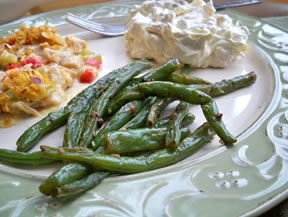|
Fresh Beans | Fresh Bean Preparation | Fresh Bean Cooking | Fresh Bean Tips
Dried Beans | Dried Bean Preparation | Dried Bean Cooking
| Beans |
|
A generic name given to various plants in the legume family. There are three stages of bean development, based on the maturity of the bean that determines how the bean is used. The first stage is when the bean is immature and the bean (or seed) and the pod are both very young and tender. This is the stage when the bean and pod are both eaten, either raw or cooked, and they are referred to as fresh, baby or snap beans. During the second stage, the bean begins to mature. The pod is tough but the bean can be removed from the pod, just like peas, cooked for a short period of time and eaten. Beans at this stage are referred to as fresh-shelled beans. The third stage is the point at which the pod and bean have dried on the stalk and the bean moves freely within the enclosed pod. The bean is then taken out of the pod that is to be discarded, and the bean can then be stored for future use in a variety of food dishes. At this stage the bean is referred to as a shelled, dry shelled, or dried bean. Many beans are also available as a canned or frozen product. |
| Fresh Beans |
|
Uses:
They can be eaten raw or cooked to different degrees of tenderness and eaten as a side dish. They can also be added to many different food dishes including salads, casseroles, soups, stews, and stir-fries. |
|
At Their Best:
Green and wax beans are available throughout the year but are at their best quality and price during the summer and early fall. Chinese long beans are also available throughout the year with peak season being during the summer and early fall also but these beans are more limited to where they are produced because they are sensitive to cold temperatures.
The fresh beans that do not have edible pods are available for a limited time. Fava beans in late spring to early summer, lima and cranberry in the middle of summer to early fall, and edamame beans are available summer to early fall. |
|
How to Buy:
When buying, check for freshness by bending a bean in half. If the bean is fresh, it will snap in two rather than bend. The beans should be slender, straight, brightly colored, and free of blemishes and rust spots. Select beans that are similar in length. Slender, short beans indicate that the beans are not mature and if they are thick and the beans can be seen through the pod they are over mature. Over mature beans will be tough and stringy.
Fresh beans that do not have the edible pods should have a tightly closed pod with bulges showing the beans inside. Feel beans to be sure they are firm. Pods should still be fresh and not show signs of drying. If the beans have already been shelled, they should be plump with no signs of shriveling. |
|
Storage:
Beans should be stored in a cool place. If they are not going to be used for 2 or 3 days, store in a perforated bag in the crisper area of the refrigerator. They can be stored in the refrigerator for up to 5 days. They are best if eaten shortly after harvesting. Do not wash until ready to use. If beans are not going to be used within 5 days, they can be frozen or canned to preserve. They should be preserved the day they are harvested for best results.
Fresh shelled beans should be stored in a plastic bag in the refrigerator. Store for 1 to 2 days. |
|
Cranberry Beans |
Fresh cranberry beans are sometimes available during the summer in local markets. The pod and beans are marked with red streaks. The pods are not edible but the beans make a good side dish or they can be added to other cooked dishes, such as stews and soups. |
Dragon Tongue Beans
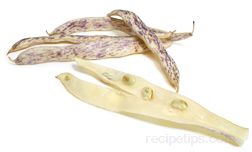 |
A type of snap bean that is similar to the green bean with an editable pod, except the pod is flatter and has purple colored strips running down a cream background. This bean can be eaten raw or served as a vegetable dish, providing a very distinctive and noticeably tasty bean flavor. |
|
Edamame Beans - Edible Soybean
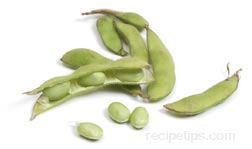
|
A fresh immature soybean sold in the pod. The soybean is harvested while it is still green and provides a bean that has a mild sweet flavor. The bean is removed from the pod before it is eaten. The pod is not edible. They can be served as a side dish, a snack, or used as an ingredient for salads, soups, casseroles, couscous, rice, pasta, and other food dishes. When cooked, the fresh beans are often placed in water, in their pod, and when the water boils, they are simmered for 5 minutes before being removed from the pod and served or added to other foods. Edamames are available throughout the year as a frozen product but can be found fresh occasionally in Asian markets, natural food stores and produce markets. |
|
Fava Beans
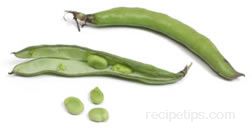 |
A young green snap or vine bean measuring an inch or more in length. The bean is shelled from the pod before eating. As a fresh bean, they can be added to salads, vegetable dishes, pasta, soups, and a variety of main dishes. Fava Beans are also available dried. |
| Goa Beans |
A type of bean that is very high in protein and has a flavor that is similar to a cranberry bean with a hint of green bean. The entire plant is edible from the roots to the leaves and the seeds. The texture of the bean is similar to a starchy green bean. Goa beans are found in specialty produce markets and are also known as winged beans. |
Green Beans
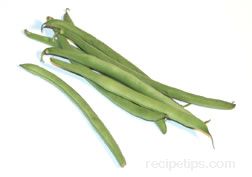 |
Also known as runner bean, snap bean, or string bean, green beans are long and slender, with green pods that are edible. These beans are one of the most popular and readily available of the fresh beans. When preparing, the cap is typically detached or snapped from the bean pod and it may then be broken in half or kept whole for cooking. |
|
Haricots Verts Beans
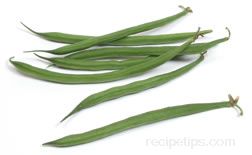 |
A small snap green bean that is long and straight in shape, tender in texture, yet crisp and very tasty. It is also referred to as a baby French green bean. The name is often confused with the haricot bean, a small white dry bean commonly used to make baked beans. |
Italian Flat Bean
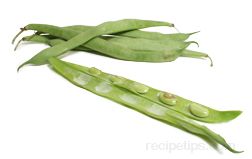 |
A light green or purple bean that is similar to a common green bean except that it is flatter. They can be substituted with green beans in most recipes. Italian flat beans can be eaten raw as a side dish or added as an ingredient in other dishes. Do not overcook, this may cause the beans to become soft and mushy. Italian Flat Beans may also be referred to as Romano beans, snap beans or simply Italian Green Beans. |
Lima Beans
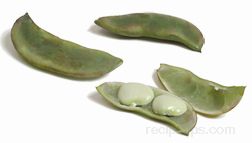 |
Fresh lima beans have bright colored pods, which snap when bent. The pods are not edible. The beans have a sweet flavor and tender texture. They have a smooth, flat shape and are light colored. Their colors range from light beige to light green. The greener the beans are the better flavor they have. Lima beans that have more greenish color to them are more tender and have a better flavor. A large variety called Fordhooks is also referred to as butter beans. There is also a small, milder tasting variety called baby lima beans. Fresh lima beans should generally be cooked before eaten. The only type that should be eaten raw would be very young tiny beans. |
|
Long Beans
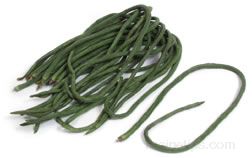 |
A long Chinese bean that can measure from one to three feet in length. They have a mild taste similar to string beans and are light green or dark green in color. The light green beans have a sweater flavor than the dark green beans and both can be cooked in the same manner as string beans. When using in stir-fries or other dishes, the beans should be chopped up before adding. |
|
Purple Wax Beans
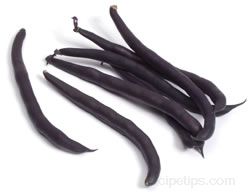 |
A type of snap bean or string bean that is very similar to a green bean except for the purple color. This bean is picked at the early or immature stage of development when it is tender, sweet and crisp, and eaten with the pod on. The wax bean can also be yellow in color and is referred to as the yellow wax bean. |
|
Wax Beans
 |
A Wax Bean is a snap bean that is a golden yellow or purple colored version of the green bean. It is harvested and eaten during the early stage of maturity, when it is tender, sweet and crisp. It is also referred to as the yellow or purple wax bean. |
|
Dried Beans |
|
Uses:
Dried beans need to be cooked before they are consumed. Before they are cooked they most often require soaking. They are served as a side dish or added to other dishes, such as soups, stews, chili, casseroles, and salads. |
|
At Their Best:
Dried beans are available throughout the year and most are found near the rice in most food stores. Some can be found in health food stores and specialty markets. |
|
How to Buy:
When purchasing bulk beans look for beans that are firm and uniform in size and that are not split, broken, or shriveled. Also check beans for tiny pin-hole markings, which is an indication of insect damage. Purchase dried beans in a store that has a fairly good turnover of beans so what you are purchasing is fresh. If beans are packaged, avoid packages that are damaged. |
|
Storage:
Dried beans can be stored up to a year at room temperature in an airtight container. The older the beans are the longer they will take to cook so do not mix new beans with old beans when cooking. This will cause uneven cooking.
If storing cooked beans, place in an airtight container and store in the refrigerator for up to 4 days. Cooked beans can also be frozen for future use. Spread cooked beans out evenly on a baking sheet and then place in the freezer until frozen. Then remove from the freezer and place in an airtight container. Return to the freezer and when needed, the beans will be ready to add to your dish, remove only the amount that you need. The frozen beans can be stored in the freezer for 5 or 6 months. |
|
Adzuki Beans
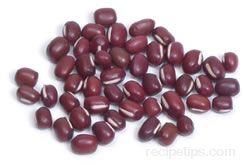 |
A small, oval bean, reddish-brown to maroon in color, and native to China. It is usually sold in a dried form, but can also be purchased as a paste or flour. It has a sweet taste and is used in many Asian dishes, but is especially useful and flavorful in desserts. |
|
Anasazi Beans
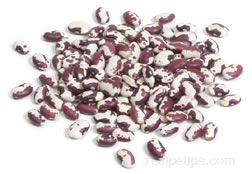
|
A dried bean considered to have originated in New Mexico as a traditional Native American food for over a thousand years. This bean, which has a dark red and white color, is a relative to the pinto bean. When cooked, the bean becomes light beige or pink colored and provides a meaty texture with a mild flavor that is somewhat sweet tasting. Uncooked beans can be stored in glass containers for up to a year, while cooked beans should be refrigerated and can last for up to a week. This bean may also be referred to as a cave bean, a New Mexico cave bean, a New Mexico appaloosa, the Aztec bean, and Jacob's cattle bean. |
|
Black Beans
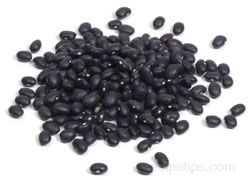 |
A popular type of small bean with a cream-colored flesh and black skin that has a slightly sweet flavor and a mealy texture. Black beans can be dried or sold precooked. They are also known as turtle beans. |
|
Black-Eyed Peas (Cowpea)
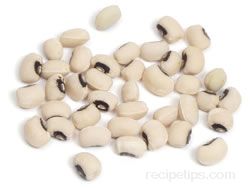
|
A type of legume that originated in Asia, but is also grown in the southern United States. It is an oval-shaped bean, ivory in color with a small black spot, referred to as the "eye." The "eye" is where the bean is attached to the pod and may also be yellow, brown or red in color. It has a pea-like flavor and a firm texture if not overcooked. This bean is available as a fresh or dried bean to be used in soups, side dishes and casseroles. The southern states in America have a popular dish known as Hoppin' John that uses the cowpea as the key ingredient. This bean is also known as a cowpea, or a black-eyed cowpea. |
|
Cannellini Beans
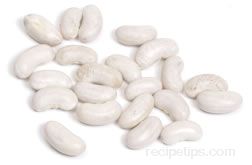 |
A white oval dried bean with a thin skin and mild flavor. It is also known as the white kidney bean and is available canned or dried. If Cannellini beans are unavailable, white navy beans or Great Northern beans can be substituted. |
|
Chickpeas (Garbanzo Beans)
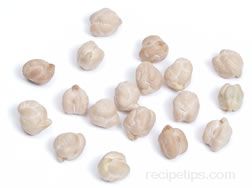
Chickpeas
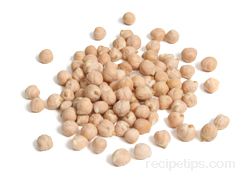
Baby Chickpeas
|
Also known as a garbanzo bean, this legume is a round, tan-colored bean with a slightly nutty flavor. It is used as an ingredient in soups, salads, side dishes, pasta dishes, and dips as a popular ingredient in Middle Eastern, Indian, Italian, Spanish, and Latin-American cuisine. It is also ground and processed into garbanzo bean flour for use in baked goods. It is also often roasted into a nut-like form and used as a snack and as and ingredient in the Middle Eastern dish, falafel. Dried or canned chickpeas are readily available in most food stores. Baby Chickpeas, which are about half the size of regular chickpeas, can be found in large well stocked food stores. |
|
Corona Beans
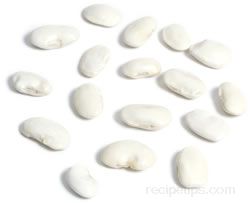 |
A very large, broad white bean, common to Italy, but not commonly grown in many regions throughout the world. Similar in appearance to a large lima bean, it is a very meaty bean that becomes much larger when cooked. As a dried bean it is used in soups, stews, and served as a side dish. |
|
Cranberry Beans
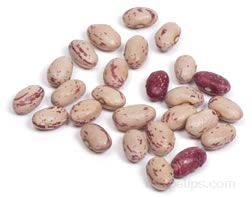 |
A dry shelled bean that has a large, knobby beige pod with patches of red. The inside of the bean is cream-colored with red streaks and provides a delicious nutlike flavor. Cranberry beans must be shelled before cooking. The red color tends to fade as they are cooked. They are also known as an Italian Borlotti. Pinto beans can be used as substitutes or if necessary, red kidney beans. |
|
Fava Beans
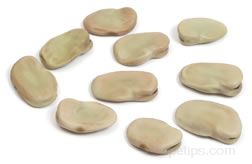
|
A large green snap or vine bean measuring an inch or more in length with an inner bean shaped like a kidney bean or oversized lima bean. Fava Beans can be purchased fresh or dried. When using dried beans, it is best to use beans that have been split so that the very tough skin is easier to remove and the cooking time will be faster. As with any dried bean, soaking is required to re-hydrate the beans before they are cooked. |
| Flageolet Beans |
A variety of bean often considered being an immature kidney bean, about a half-inch in length, with a pale green color. They can be purchased fresh in some markets, canned, or dried. Flageolet beans are small oval dry shelled beans that can be white (flageolet blanc), black (noir), yellow (jaune), red (rouge) or green (vert) in color. They are also referred to as fayot or chevrier vert beans and are considered a good complement to roast leg of lamb. Dried beans must be soaked before they are prepared. |
|
Great Northern Beans
 |
A white, kidney-shaped bean with a mild flavor that is available dried or canned. It can be useful in baked bean dishes and soups. When Great Northern beans are unavailable, white kidney beans or navy beans are good substitutions. |
|
Kidney Bean
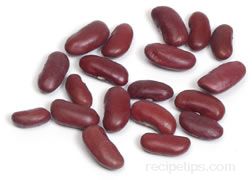 |
A dried kidney shape bean that is reddish brown in color, strong flavored and has a slight mealy (powdery) texture. The beans can be cooked as their own dish or can be added into other dishes, such as chili, casseroles, refried beans and salads. They are available dried or in cans, precooked. Dried beans require soaking before cooking. |
|
Lima Beans
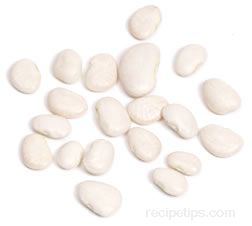 |
A flat, light green, kidney shaped bean that has a mild flavor and soft texture. They are available fresh in the shell, dried, frozen, and can processed. Fresh Lima Beans in the shell can have the beans removed by breaking the stem and pulling down to remove the string, which opens the pod so that the beans can be removed by running a finger along the inside of the pod. This bean is commonly referred to as calico, Madagascar, or butter beans and is available as baby or mature beans. |
|
Lupini Beans
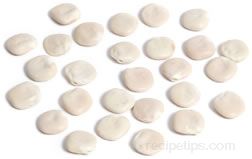
|
A large dried bean that is round in shape, white in color and similar to a fava bean. Both a sweet albus and bitter albus variety of this bean seed are grown for consumption, however, the bitter albus if not soaked may be toxic. Native to Italy, the bitter bean is soaked overnight and often marinated to remove the bitter taste that is due to higher levels of alkaloids contained in the bean. When soaked, the alkaloids leech from the bean into the water. It is also known as albus lupin, white lupin, European white lupin, or tremmocos. In addition to being a food source, this bean is ground into a powder to be used as a facial scrub in Mediterranean countries. |
|
Marrow Beans
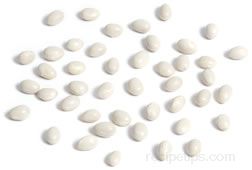 |
A plump looking dried bean, common in Italian cooking, that is white in color and round in shape. When cooked, this bean has a creamy, meaty texture that provides a flavor that is somewhat similar to smoked bacon. It is a bean that goes well with braised meats, soups, stews, or when served as a side dish. Great northern or navy beans can be substituted when necessary however, they do not provide that same size or flavor provided by marrow beans. |
|
Moth Beans
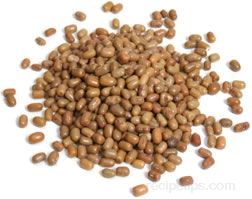
|
A small bean, very common in India, that provides a good source of protein when cooked as a food dish. Pronounced as "moat" this bean is oblong in shape, small in size and light tan to brown in color. The inner meat, which is golden yellow in color, provides a earthy and somewhat nutty flavor for main dishes, side dishes or snack food (sev) made with this bean. Generally the moth bean is eaten as a sprout or as a dhal (also known as dal) which is a hulled bean. Whole beans which have not been hulled, are also consumed and require soaking prior to cooking. They should remain in water for at least 8 hours after which they can be drained, placed in fresh boiling water, and cooked for 15 minutes or longer. The hulled beans, or dals with the husk removed may not need soaking and require shorter cooking times. Other names for this bean include dew bean, haricot, mat, mot, muth, and papillon. |
|
Mung Beans

|
A tiny, round dried bean (about 1/8 inch in diameter) with a thick outer skin that may be green, brown or black in color. When peeled, the inside of the bean provides a golden yellow or mustard-colored, soft-textured meat that is somewhat sweet in flavor, tender when cooked and easily digested. Originating in India, the bean is referred to as Yellow Mung, Yellow Split Mung or Moong Dal, where it is often used to make curries and a food dish referred to as "Dal."
Mung beans are prepared as whole, peeled, or split for use in pilafs, soups, stews, and bean dishes. They are also ground for use in flours and as an ingredient for various food mixtures. When made into flour, the starch in the ground bean enables it to be used to make a very thin noodle known as bean-threads or cellophane noodles. The flour also is used to make breads and sweets. Another common use for this bean is to produce transparent bean sprouts, which become a crunchy and flavorful ingredient for salads, egg dishes, stir-fried dishes, and sandwiches.
|
|
Navy Beans
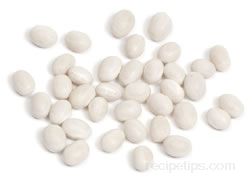 |
A pea-sized, off-white, oval shaped legume, which is also called the Yankee bean. Its name comes from the fact that it has been a staple food for the U.S. Navy since the middle 1800's. This bean is also referred to as the Boston bean, fagiloi, haricot blanc (white), or the pearl haricot bean. It is a common ingredient used in soups, salads, bean dishes (canned pork and beans), and chili. Cannellini, flageolets, great northern, or dry lima beans could be good substitutes when necessary. |
|
Pink Beans
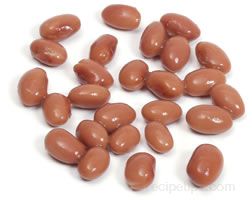 |
A variety of legume that is small and oval-shaped, pale pink in color, and grown throughout the world. The bean pods are picked when they are young and tender and then dried for use in a variety of food dishes. The pink bean is most often used for soups, stews, rice dishes, refried bean dishes, and chili con carne, providing a rich, meaty flavored bean with a somewhat powdery texture. Also known as Habichuelas Rosadas in Spanish, pink beans can be substituted for or added with kidney and pinto beans in any recipes requiring the pink beans. |
|
Pinto Beans
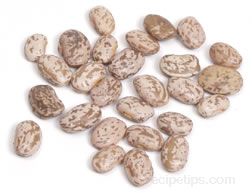 |
A mealy-textured bean that has a blotchy brown and tan colored skin. The oval shaped bean makes a good refried bean and is used in other dishes, such as beans and rice, chili, soups and stews. They are available dried or precooked in cans. Dried beans must be soaked to re-hydrate before using. |
|
Red Beans
 |
Small, dark red beans that have a slightly sweet taste. They are available precooked in cans or dried, which require soaking to rehydrate. These are popular beans to use in Mexican dishes, such as refried beans. Also referred to as small red beans. |
|
Scarlett Runner Bean
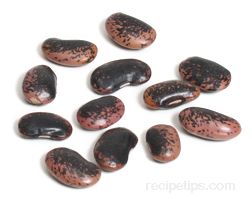
|
A variety of bean, which is also referred to simply as a Runner Bean that can be eaten as a fresh green bean, a fresh podded bean or a dried bean. With a flavor similar to a butter bean, the Scarlett Runner Bean can be harvested when young to be eaten as a green bean, however the outer flesh may be somewhat fibrous and rough in texture depending on the age of the bean. While fresh, the inner bean can be removed from the pod and eaten like a sweet pea, providing a distinctive nutty bean flavor that goes well with other vegetables, mushrooms and casseroles. Or, the bean can be dried and prepared for soups, stews and bean side dishes. As the plant develops and grows, the Scarlett Runner Bean provides an enjoyable reddish-orange flowering bud which can be used to garnish salads. |
|
Soybeans
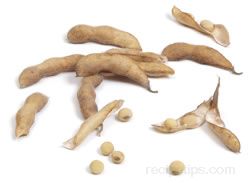
Dried Yellow Soybean

Black Soybeans
|
A nutritious legume that is round in shape, small in size, and very versatile as an ingredient for a variety of foods and food dishes. Fresh soybeans are green in color while the dried soybeans are either yellowish-tan or black in color. They can range in size from as small as a pea to almost 1/2 inch in diameter. Soybeans are high in protein and low in carbohydrates. Black soybeans, common in Asian cooking, have a slightly sweeter flavor than yellow soybeans which have a bland bean flavor. The dried or mature bean is used to make a variety of products, such as tofu, soy milk, soy sauce, and snack foods. Although it is not a popular cooking bean, because of its bland flavor, it can be presoaked and then used as an ingredient for soups, stews and casseroles. Soaking the mature bean improves the flavor and decreases the amount of time required for cooking. Dried soybeans and soybean products are widely available in supermarkets and health-food stores.
Soybeans are also referred to as soya, soya bean, soja, or soi. |
|
Stuben Yellow Beans
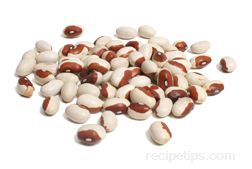
|
Although it is not yellow in color, this bean does have a multi-colored look, displaying reddish brown and black hues over a white background. Much like a calypso bean in size and a spotted appearance, the Steuben Yellow Bean keeps its coloring and shape after it is cooked, providing a mealy-textured oval-shaped bean for soups, stews, salads, and mixed vegetables. Common throughout Maine, the Steuben Yellow Bean is often used to make Maine baked beans, a popular East coast bean dish. The Steuben Yellow Bean is also referred to as a Steuben Yellow-Eye bean, a Butterscotch Calypso bean, a Molasses Face bean, and a Maine Yellow-Eye bean. |
Fresh Bean Preparation
Fresh bean preparation basically involves cleaning and trimming the beans. The less the bean is cut the sweeter and crisper is will be. Cutting the beans lengthwise, French Style, should be done on older, more mature beans only.
| Wash beans under cold water until free of dirt. To prepare for cooking, snap off the stem end of the bean. |
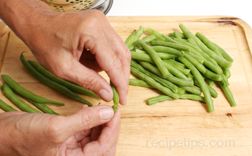 |
| The stem end can also be cut off with a knife. The opposite end can also be cut off but it isn's necessary. The beans can be left whole or cut at an angle into smaller sections. |
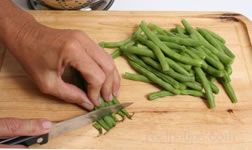 |
Fresh Bean Cooking
Fresh beans can be cooked using several methods, such as boiling, steaming, stir-frying, and microwaving. When cooking fresh beans, use as little water possible and do not overcook to retain the bright color and tender-crips texture of the bean. Several cooking methods are explained below.
Boiling
| Add approximately an inch of water to the bottom of a saucepan. Add salt and bring the water to a full boil. Add the beans to the boiling water. |
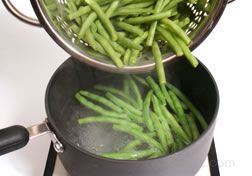 |
| Allow the water to come to a boil again and then lower the heat so that the beans are simmering. |
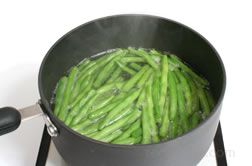 |
| Simmer for 5 to 10 minutes, taste testing after 5 minutes. Beans should be a tender crisp when done. If not done when testing, cook for 1 to 2 more minutes and check again. |
 |
|
When beans are done to the desired tenderness, they can be served immediately or if they are going to be served later or added to a cold dish, they should be place in ice water or ran under cold water to stop the cooking.
Beans can be served with just salt and pepper for seasoning or they can be complemented by the addition of melted butter, herbs and lemon juice. They can also be added to soups, stews, stir fries, casseroles and salads. |
 |
|
Note: If an acidic ingredient, such as vinegar or lemon juice, is added to the cooking water, the beans will lose their bright color. Acidic ingredients should be added after the beans have been cooked so that their color is preserved. |
Steaming
- Add enough water to the pot so that it is below the bottom of the steamer basket when it is placed in the pot. Bring the water to a full boil using a high heat.
- Place beans in the steamer basket and place the basket in the pot over the boiling water, making sure no water is coming up through the holes in the steamer. Cover and cook for 3 to 5 minutes, until beans are tender-crisp.
- Remove steamer basket from pot and prepare beans for serving.
Stir-frying
- Cut beans into 1 inch pieces or leave them whole.
- To stir-fry 1 lb. of green beans, add 1 to 2 tablespoons of oil to the wok or deep-sided frying pan.
- Heat oil until very hot and then add the beans to the hot oil.
- Cook on medium-high, stirring constantly. Season with salt and pepper.
- For added flavor add some onion and garlic.
- Stir-fry until beans are tender crisp. Serve while hot.
Fresh Bean Tips
- When preparing beans, cut them as little as possible for the best taste and a fresh crisp texture.
- When boiling, steaming, and microwaving, use the least amount of water possible with the least amount of cooking time. Do not overcook.
- Do not overcrowd the beans in the pan, the fewer the better. Do not cook more than one pound in a pan. If cooking more, use separate pans. The beans will cook faster and have better flavor.
- Green beans can be cooked ahead of time and stored up to a few days if desired. Cook until crisp-tender using your method of choice. Rinse in cold water and dry thoroughly with paper towels. Store refrigerated, wrapped in plastic or sealable bag for up to 4 days.
- Note: Green beans will continue to cook when you remove them from the heat so if you are not going to serve them immediately it is important to rinse them with ice cold water to stop the cooking process and then reheat quickly just before serving. You can try to undercook them if they are going to set for a period of time without rinsing in cold water but this method may make it hard to control them being done just as you like when serving.
- If the green beans have been cooked ahead of time, reheat them just before serving, using the least amount of cooking time as possible.
Dried Bean Preparation
The many varieties of dried beans are prepared for cooking in basically the same manner. They are first cleaned and then presoaked to cut down on the amount of cooking time. Use lukewarm water when rinsing and soaking dried beans. Cold water may cause the beans to toughen. Follow the steps below for cleaning and soaking.
Cleaning Dried Beans:
- Spread dried beans out in a single layer on a white kitchen towel or a light colored work surface. Check for and discard any dirt, tiny stones, and damage beans.
- After checking through the beans, place them in a strainer and rinse thoroughly under lukewarm water.
Long Soaking Method
- After the beans have been cleaned, place them in a large pot or bowl and cover with 2 to 3 times the volume of cool water.
- They should be allowed to soak for six to eight hours at room temperature.
- At least once during the soaking time, it is a good idea to pour off the water and add fresh. Pouring off the water the beans have been soaking in will help to get rid of some of the indigestible complex sugars that cause flatulence (gasiness).
- Pour off all the water from the beans when they are done soaking. Do not use this water to cook the beans.
- Place the beans in a strainer and rinse with cool water before cooking.
Quick Soaking Method
- After the beans have been cleaned, place them in a large pot and cover with 2 to 3 times the volume of cool water.
- Over medium high heat bring the water to a boil. Boil for 2 minutes and then remove from the heat.
- Cover the pot and allow beans to stand for 1 hour.
- Pour off all the water from the beans when they are done soaking. Do not use this water to cook the beans. Pouring off the soaking water will help eliminate some of the indigestible complex sugars that cause flatulence (gasiness).
- Place the beans in a strainer and rinse with cool water before cooking.
Soaking Tips:
- When soaking beans, some may float to the top along with some loose skin. This is an indication that the beans are old and contain little moisture. Skim any beans or particles off the surface and discard them.
- Do not soak or rinse beans in warm or cold water. The water should be just cool. The cold water has a tendency to toughen the beans.
- Do not add salt to the soaking water because it will toughen the beans outer layer and not allow the bean to absorb moisture.
Dried Bean Cooking
There are several methods that can be used to cook dried beans. Cooking times will vary depending on the variety, size and age of the beans. Realize that dried beans will double in size after soaking and then tripled in size after cooking. One cup of dried beans will equal three cups cooked.
Flavorings, such as herbs, onions, celery, and carrots, can be added to the water to enhance the flavor of the beans. Salt, sugar and any acidic ingredients, such as vinegar, citrus juice, or wine, should not be added until the beans are almost tender. If added at the beginning of the cooking process, they will harden the skins on the beans and prevent them from absorbing the necessary liquid to soften them.
Shown below are several method for cooking dried beans.
Stove Top
- Drain and rinse soaked beans before adding to the cooking pot. Do not use a pot that is made from a reactive type metal, such as aluminum. The beans can take on a metallic taste when cooked in this type of pot.
- Add beans to the pot and cover with lukewarm water or unsalted broth until the level is about 2 inches above the beans. Add 1 tablespoon of cooking oil to the water to help reduce the amount of foaming.
- Bring the liquid to a gentle boil, reduce the heat, partially cover, and simmer until tender.
- COOKING NOTES:
- Do not allow beans to boil rapidly, which will cause them to burst.
- If the beans are foaming, skim off the foam and discard.
- If the level of water gets low, add more boiling water to get the level back up.
- Gently stir beans while they are cooking but keep the stirring to a minimum to prevent bursting the skins and having the beans become mushy.
- Small beans may take from 30 to 45 minutes, where medium size beans may take 1 to 1 1/2 hours.
- Add salt at the end of the cooking time when the beans are almost tender. Cooking time will vary depending on the variety and dryness of the beans.
- Do not overcook and allow the beans to become mushy.
- When tender, remove from the heat and allow them to set in the cooking liquid while they cool so that they do not dry out.
Baked
- Drain and rinse soaked beans before adding to the pot.
- Gently pour beans into a pot that can be used on the stove top and in the oven. It will also need to have a lid.
- Preheat oven to 325°F.
- Add enough fresh lukewarm water until the level is 3 inches above the beans. Add desired flavorings.
- Place the pot on the stove top and bring it to a boil.
- After it comes to a boil, cover and place in the preheated oven.
- Bake until the beans are tender but not mushy, approximately 40 to 60 minutes. Baking time will depend on the variety and dryness of the beans.
- When tender, remove from the oven and allow them to set in the cooking liquid while they cool so that they do not dry out.
Pressure Cooked
- Drain and rinse soaked beans before adding to the pressure cooker.
- Place beans in the pressure cooker but do not fill the cooker more than half full to allow for expansion of the beans.
- Salt has to be added at the beginning of cooking because the pressure cooker cannot be opened while it is cooking the beans. The pressure in the cooker keeps the salt from softening the beans.
- Add approximately 1 teaspoon of vegetable oil to the pressure cooker to help reduce the foam that can clog the steam vent. The steam vent may need to be pressed occasionally so that it will let off steam and unclog the vent.
- After the pressure builds up in the cooker, the heat should be reduced to medium pressure or 15 pounds per square inch.
- Cook beans from 10 to 25 minutes, depending on the variety and age of the beans.
Pressure cooking reduces the cooking time by almost half of the standard time of cooking on the stove top or baking. The disadvantage of using a pressure cooker is that once it is at the proper pressure for cooking the beans, the cover cannot be removed to check cooking progress. It makes it hard to determine if the beans are done to the proper tenderness so there is more of a chance that the beans will be undercooked or overcooked. |



















































